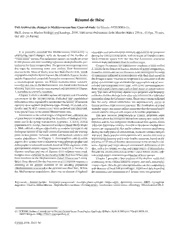
Fish biodiversity changes in Mediterranean Sea: Cases of study PDF
Preview Fish biodiversity changes in Mediterranean Sea: Cases of study
Résumé de thèse Fish biodiversity changes in Mediterranean Sea: Cases of study, by Ernesto AZZURRO(1). Ph.D. thesis in Marine Biology and Ecology, 2006, Università Politecnica delle Marche (Italy), 238 p., 43 figs, 35 tabs, 661refs (in Italian). It is generally accepted that Mediterranean biodiversity is separation and mitochondrial diversity appeared to be preserved u n d e rgoing rapid changes, with an increase of the number of during the Linosa colonization, with no traces of founder events. “warm water” species. Non indigenous species are deeply involved Such evidence agrees with the idea that Lessepsian migration in this process and their incoming represents an unpredictable per- involves many individuals from its earliest stages. turbation for local communities. The present investigation faces Chapter 5 examines the reproductive condition of early settled this topic by examining some case studies. New documented S. luridusin the Island of Linosa. Aspects of gonad morphology, species in the Strait of Sicily were two Indo-Pacific fish, which f e c u n d i t y, atresia and oocyte dynamics were investigated by using migrated through the Suez Channel, the rabbitfish Siganus luridus 43 specimens collected in concomitance with their first record in and the bluespotted cornetfish Fistularia commersonii. Moreover, the Pelagie Islands. Ovarian development was consistent with the a circumtropical species, the Whaoo Acanthocybium solandri, group-synchronous type and testicular organization was of unre- recorded just once in the Mediterranean, was found in the Straits of stricted spermatogonial testis type, with cystic spermatogenesis. Messina. Such new records were reported and described in Chapter Both males and females had reached final stages of gonad matura- 2, according to scientific standards. tion. The rates of follicular atresia were moderate and fecundity Chapter 3 offers a detailed update of S i g a n u sand F i s t u l a r i a estimates did not diverge from what was observed in a reference occurrences in the Mediterranean. Published and unpublished population along the Lebanese coasts. These observations indicated information were organized to reconstruct the history of invasion that the early settled rabbitfishes are reproductively active at and to re-draw updated distribution maps. Overall, 45 records of S . Linosa and have high invasive potential. The distribution of gonad l u r i d u sand 36 of F. commersoniiwere reviewed and discussed, maturity stages and gonad indices suggested that the reproductive with special focus on the central Mediterranean area. season could be delayed with respect to Levantine populations. Information on the initial stages of dispersal and settlement are The new invasive phenomenon in Linosa, generates some of great interest in understanding the dynamics of biological inva- questions about the ecological interactions among new settled rab- sions and in designing management responses. Anewly settled bitfishes and the two indigenous Mediterranean fish species, S a r p a population of S. luridus, that arrived in Linosa Island (Sicily Strait) s a l p aand Sparisoma cre t e n s e. In order to determine whether these in 2000, offered a unique opportunity to examine ecological and species are segregated by diet and to estimate resource partitioning biological aspects of the early phase of invasion and the starting during the early phase of colonization, stomach contents analysis point to test genetic variation within and between colonist and was used. Some peculiar characteristics of S. luridusdiet were a source populations. In Chapter 4, demographics and dynamic high feeding intensity and a wide trophic spectrum, based on the aspects of S. luriduswere evaluated by using phylogeographic and presence of 37 taxa of benthic macrophytae in the stomachs con- demographic (coalescent) methods based on DNAsequences of the tents. S i g a n u sand S a l p ashowed considerable differences of the mitochondrial control region. Sequences from 95 S. luridus, 25 diet, with a low trophic overlap and a high degree of dissimilarity. Siganus rivulatus and one of S i g a n u s (Lo) v u l p i n u s were used. Despite the recent colonization of the Linosa Island, results indi- Samples were collected in one locality in the Red Sea (Eilat) and cate a high degree of resource partitioning of these species. three localities in the Mediterranean (Israel, Greece and Linosa, Chapter 7 presents a first analysis of the shallow rocky fish Italy). Data showed (for the first time in a Lessepsian migrant) a community in the Linosa Island by nightly and daily underwater lowering of the genetic diversity of the invading population visual census. Results provided information on the composition (Mediterranean) compared to the parental one (Red Sea). Wi t h i n and structure of local fish assemblages. Additional data regarding the Mediterranean populations, there was no pattern of regional the abundance and distribution of S. luriduswere also presented. Key words. - Siganus luridus - Fistularia commersonii - Acanthocybium solandri - Sarpa salpa - Sparisoma cretense - MED - Lessepsian migration - Genetic differentiation - Reproductive condition - Feeding habits - Underwater visual census - Histology -Mitochondrial DNA. (1) ICRAM, Istituto Centrale per la Ricerca Scientifica e Tecnologica Applicata al Mare. Sede di Milazzo, Via dei Mille 44, 98057Milazzo (ME), ITALY. [[email protected]] Cybium 2006, 30(1): 64.
